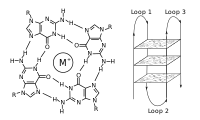
Quantitative Measurement of Spatial Effects of DNA Origami on Molecular Binding Reactions Detected using Atomic Force Microscopy.
Sign Up to like & getrecommendations! Published in 2019 at "ACS applied materials & interfaces"
DOI: 10.1021/acsami.9b01691
Abstract: DNA origami is a ubiquitous nanostructure that can be used as a universal scaffold for constructing molecular motors, nanosensors, nanodrugs, and optical devices. Understanding the inherent heterogeneity of DNA origami structures is crucial for optimizing… read more here.
Keywords: effects dna; microscopy; dna origami; binding reactions ... See more keywords

LNA effects on DNA binding and conformation: from single strand to duplex and triplex structures
Sign Up to like & getrecommendations! Published in 2017 at "Scientific Reports"
DOI: 10.1038/s41598-017-09147-8
Abstract: The anti-gene strategy is based on sequence-specific recognition of double-strand DNA by triplex forming (TFOs) or DNA strand invading oligonucleotides to modulate gene expression. To be efficient, the oligonucleotides (ONs) should target DNA selectively, with… read more here.
Keywords: lna effects; duplex triplex; effects dna; strand ... See more keywords

The effects of DNA repair polymorphisms on chromosome aberrations in the population of Kazakhstan
Sign Up to like & getrecommendations! Published in 2020 at "International Journal of Radiation Biology"
DOI: 10.1080/09553002.2020.1711460
Abstract: Abstract Purpose: To analyze the effects of DNA repair polymorphism and other factors on the frequency chromosome aberrations in an irradiated cohort of subjects living around the Semipalatinsk nuclear test site and non-exposed group of… read more here.
Keywords: frequency chromosome; dna repair; effects dna; chromosome aberrations ... See more keywords

Structure, antioxidant properties, and protective effects on DNA damage of exopolysaccharides from Clostridium butyricum.
Sign Up to like & getrecommendations! Published in 2023 at "Journal of food science"
DOI: 10.1111/1750-3841.16609
Abstract: Exopolysaccharides (EPSs) of probiotics are naturally nontoxic antioxidants with some interesting biological activities. This research aims to explore the structural and antioxidant properties of the EPS from Clostridium butyricum, a probiotics widely existed in human… read more here.
Keywords: structure antioxidant; protective effects; effects dna; antioxidant properties ... See more keywords